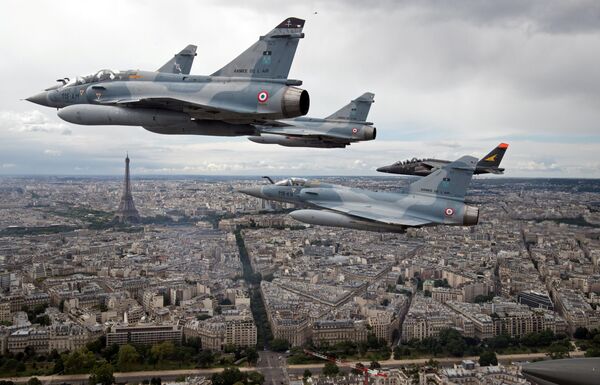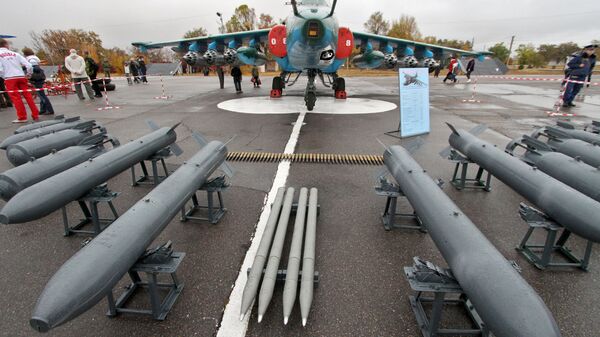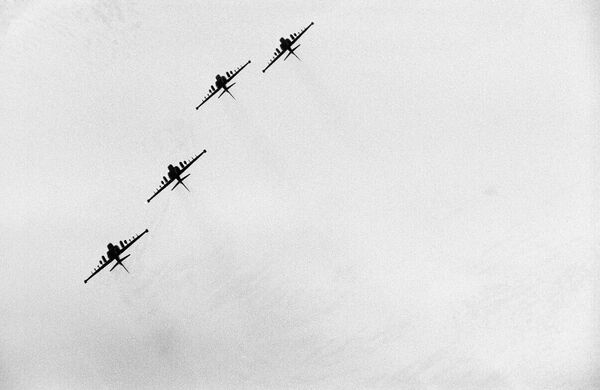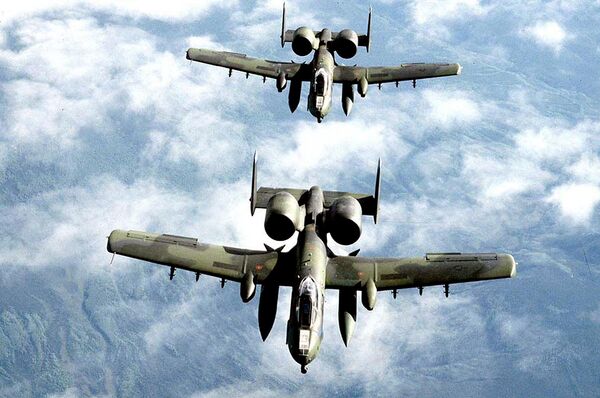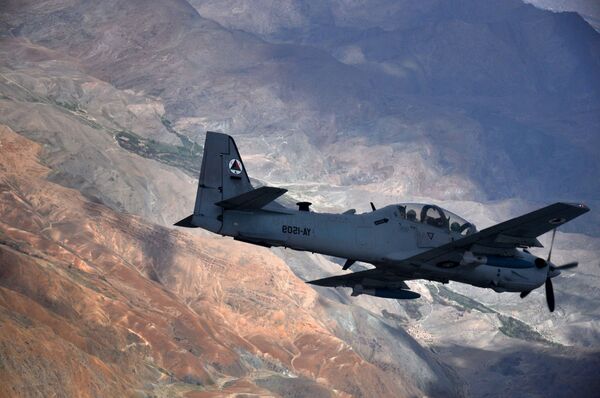With their comparatively slow cruising speed, strong armor and complement of deadly air-to-ground weaponry, close air support (CAS) aircraft provided crucial tactical support on the battlefields of World War II. With the progression of the Cold War and the advent of the jet engine, it may have seemed that these planes' days were numbered.
But as RIA Novosti military journalist Andrei Kotz points out, "the experience of the armed conflicts of the second half of the 20th century (and the first wars of the 21st) has actually demonstrated that these simple, slow and unpretentious aircraft are able to perform missions where much more advanced, expensive and modern aircraft have proven useless."
Russia's Su-25
The Su-25 Grach ('Rook') made its maiden flight in early 1975, and introduced five years later. Nearly 40 years on, over 1,000 Su-25s have been built, and production continues, serving as testament to the Su-25's resilience, reliability and practicality.
Kotz writes: "The Su-25 is equipped with a powerful complement of weaponry, including guns, air bombs of various calibers and designations, guided or unguided air-to-ground missiles, and guided air-to-air missiles. A total of 32 types of weapons can be installed on the ground attack plane, not counting the built-in 30mm GSh-30-2 dual-barrel autocannon."
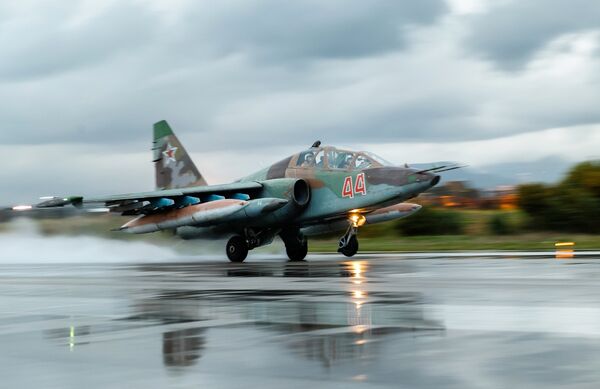
"The Su-25's security is the plane's calling card," the journalist stressed. The pilot's cabin is protected by aviation-grade titanium armor 10-24 mm thick. The pilot is protected from small arms fire with a caliber up to 12.7mm, and from anti-aircraft gun fire with a caliber up to 30mm.
Furthermore, the aircraft's critical systems are encased in titanium and duplicated, meaning that if one set of systems is damaged, the backup turns on.
The Su-25's baptism by fire took place during the Soviet War in Afghanistan in the 1980s, where it engaged the Mujahedeen, the CIA-funded precursor to the Taliban. Kotz recalled that the attack aircraft's low flight speed "allowed it to conduct accurate strikes in difficult conditions in mountainous terrain, assisting infantry which had found itself in seemingly hopeless situations."
In the course of the war, Soviet Army Aviation lost 23 Su-25s, but not a single Su-25 pilot. "There were cases of Su-25s returning to base after a mission with over 100 punctures to their fuselage. It was the Afghan War that gave the 'Rook' its second unofficial nickname – the 'flying tank'."
America's A-10 Thunderbolt II
The US developed its own close air support aircraft, the A-10 Thunderbolt II, also known as the 'Warthog', in the early-to-mid-1970s, with the Air Force adopting the aircraft into service in 1977.
With the Pentagon initially skeptical of the slow, seemingly fragile, cumbersome plane against the backdrop of the then-new 'futuristic' F-15 and F-16 tactical and multirole fighters, which entered service during roughly the same period, debate over the Warthog's future persisted throughout the 1980s. Naysayers lost out decisively only during Operation Desert Storm, during which an estimated 150 Warthogs destroyed over 3,000 Iraqi vehicles, with only 7 A-10s lost during the entire campaign.
Of course, debates have ensued regarding the reliability of these estimates, given that most of the Iraqi forces were destroyed as they retreated from Kuwait along the so-called Highway of Death. Nevertheless, the Gulf War secured Warthog's reputation, at least against a weaker enemy. Since then, the A-10 has been deployed in the US wars from Yugoslavia, to Afghanistan, Iraq, Libya, and Syria.
"The main feature of the Warthog is its main gun," Kotz recalled. "The aircraft is literally built around its huge seven-barrel Gatling-type cannon, capable of piercing enemy tanks with its 30-mm armor-piercing or high-explosive rounds, each weighing nearly half-a-kilogram. Even a short burst is enough to destroy a column of tanks with a series of hits to their turret armor. In addition, the aircraft carries guided or unguided rockets, bombs and underwing guns."
Of course, the journalist suggested that it was worth noting that the A-10 also has a dubious reputation for friendly fire and civilian fire incidents. "During both Iraqi campaigns, and the US war in Afghanistan, A-10s repeatedly fired on troops which they were theoretically supposed to provide support for." Civilians too have often caught in the crossfire. Part of the problem, according to Kotz, is the Warthog's simplified electronics systems, "which do not always allow the pilot to correctly determine the target on the battlefield."

Brazil's EMB-314 Super Tucano
While the superpowers have long held a majority share of the global CAS market, Russia and the US aren't the only countries capable of producing such aircraft. In the early 2000s, Brazil's Embraer Defense began production of the EMB 314. Originally designed as a small two-seater trainer plane, the Super Tucano, fitted with Kevlar armor, two 12.7 mm machine guns and the ability to carry a 20mm gun, as well as unguided rockets and bombs, came to be seen as a genuine CAS platform.
"Of course, the Super Tucano is unlikely to strike fear in a tank column, and its Kevlar armor will not save it from an antiaircraft gun," Kotz noted. However, the aircraft has proven itself highly useful for anti-guerilla operations in hotspots around the world. This includes its use by the Colombian government to combat drug cartels; up to 200 have also been ordered by US for use in Afghanistan against the Taliban.
Europe's Dassault/Dornier Alpha Jet
Another worthy mention in the list of CAS aircraft is the Alpha Jet, an advanced trainer and light attack aircraft-turned CAS platform developed by French and West German defense firms during the 1970s and introduced in 1977. In service with 14 countries, the aircraft is designed to defeat both moving and stationary ground targets, provide direct air support, and strike at enemy reinforcement and resupply capabilities, as well as providing aerial reconnaissance duties.
According to Kotz, Alpha Jet's maneuverability amid a high combat load makes it possible to equip it with a serious arsenal, including attachable DEFA 553 30 mm cannon, or two 12.7 mm machine guns, along with up to 4 unguided or incendiary bombs on its wings. Germany has sold off its fleet of 93 Alpha Jets at the end of the Cold War, but the plane continues to be used by several NATO members, including Belgium, Canada, France, Portugal, and the UK, as well as countries across Africa, the Middle East, and Asia.
